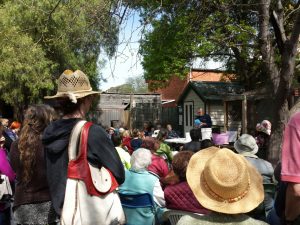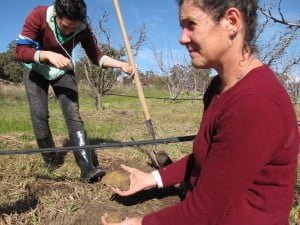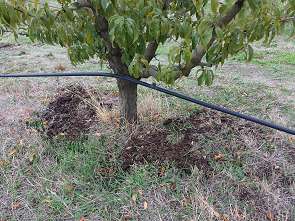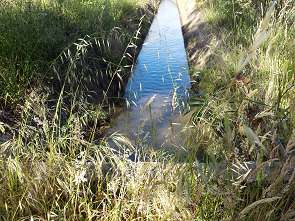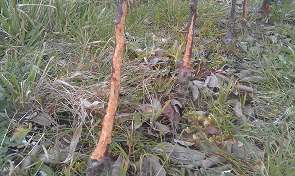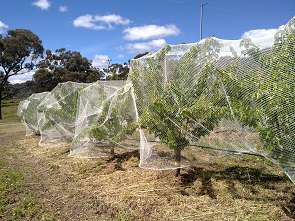We love telling the story about how we became organic, so here’s part three. (Click here if you want to have a look at part one or part two of this series. We also told you about the organic certification process here.) Learning how to grow fruit organically has been our passion for years now, but boy, did we make some mistakes in the early days (and still do, we’re proud to say—we reckon making mistakes is key to learning how to grow fruit really well!).

We’ve made a whole lot of mistakes in our journey to organic fruit growing – so hopefully you don’t have to!
However, there’s no need for everyone to make the same mistakes we did, so here’s a list of all the things we wish we’d done differently. One of the problems for us (still is, really), is that we didn’t have much of a peer group. I mean, we were always part of the local fruit growers association (Katie was secretary for years), but a lot of the reason that group got together was to go to an information session put on by one of the chemical companies spruiking for business in the district. We weren’t quite speaking the same language, if you get our drift! Sure, we all grow fruit, but we sort of come at it from different angles.
Anyway, we didn’t have any peers or mentors when we started to grow fruit organically; someone with experience, who had been there before and could tell us what to do, and how to avoid all the worst mistakes. And so that’s at the top of the list of “How to Grow Fruit the Organic Way”, which could also be called “How to Avoid all the Mistakes that Hugh and Katie Made”.
1. Find a mentor
We’ve been very lucky in finding mentors in fruit growing, but they’ve all used chemicals to grow fruit. A lot of experienced growers have been really generous with their time over the years, in teaching us about different tree training systems, varieties, rootstocks, marketing and all sorts of other useful things. But none of them were organic.
There just aren’t any certified organic fruit growers in our district, and because the organic certification system in Australia is quite fragmented, with 7 different organisations that provide organic certification, we’ve met very few in other areas.
Don’t get us wrong, we’ve met lots of fantastic organic farmers over the years, and are lucky enough to call some of them friends now, and it’s wonderful to have a peer group on that level, because we really do have lots in common. But none of them grow fruit. So we still don’t have anyone we can call or visit and say, “how did you manage your curly leaf/brown rot/grasshopper infestation….(or whatever)….this year?”
This is one of the reasons we started the Grow Great Fruit Program for home fruit growers, because it’s exactly the sort of info we were looking for – but couldn’t find – when we started to grow fruit without chemicals. (And also, it’s been a great way to build a peer group around us of people who love to grow fruit!)
2. Improve your soil before you go cold turkey from fertilisers
What we know now is that everything—yes, everything—depends on the quality of your soil when you want to grow fruit (or anything, really). Who knew? (not us, clearly!)
We sort of knew about the importance of soil, at least in theory, as we started to do courses with wonderful scientists like Elaine Ingham, Arden Andersen and Martin Staapper, where we learnt mountains of useful info about soil microbes, compost tea and soil health. But without anyone to advise us, we didn’t realise just how long it would take, or how much work it would be, to build our soil from its very damaged and depleted condition that we started in, to the point where we had restored a natural fertility system.
The mistake we made was to go cold turkey on the artificial fertilisers, before we’d restored the health of the soil. And that just left our poor fruit trees stranded! There were no microbes to speak of to provide their nutrition (only pathogenic disease-causing microbes that made them sick), so when we stopped giving them the artificial fertilisers they’d been relying on, they basically had nowhere to go for the nutrition they needed!
[In case you don’t know what we’re talking about here, “natural fertility” means the nutrition needed to grow fruit comes from healthy soil microbes, which break down organic matter in the soil into a form of nutrients that allows the trees to absorb them. It’s a healthy, sustainable system that’s been around since Adam was a boy. Modern chemical farms however use artificial fertilisers that provide the nutrition in a form the plants can take up directly – it’s sort of like hydroponics in soil. Unfortunately, the artificial fertilisers kill the soil microbes that are needed in a natural system.]
So anyway, guess what happened? Our fruit trees stopped growing! The fact that our epiphany about natural soil fertility and the decision to stop using artificial fertilisers coincided with the beginning of a long drought certainly didn’t help. Which leads us on to the next major mistake you can avoid.
The key message for you, if you want to learn how to grow fruit organically at home?
Start working on your soil first, before you completely get rid of artificial fertilisers. In fact, there are ways you can phase out fertilisers slowly, while you build up your soil microbes. If you’re trying to grow fruit in soil that has previously had lots of chemicals and artificial fertilisers (like we are), it’s important to learn about all this stuff first.
3. Give your tree enough water, at key times!
So, when we started learning to grow fruit without chemicals, we’d gone cold turkey on the artificial fertilisers, and we were also facing a drought. The mistakes we made were:
(a) not knowing the key times to use the small amount of water we had to get the most benefit (turns out it’s in spring, and just before harvest), and
(b) trying to grow too much fruit with too little water—we would have been better to use the water to grow a small amount of fruit on a few trees, and let the rest of the trees put the small amount of water available to them into growth, rather than fruit.
4. Keep your crop separate from the local wildlife
If you’re going to try to grow fruit in the same habitat as birds, kangaroos, rabbits and moose (do moose eat fruit?), then guess what? They’re going to try to eat this delicious, available new food source.
We’ve lost our entire apple and pear crop on more than one occasion to birds…including just last season, so this one has taken a while to really sink in! Why do we resist doing what it takes to protect the crop? Because it’s a nuisance, and expensive, and time-consuming. But you know what? It’s not nearly as expensive as not picking a single apple! We’ve finally learned this lesson, and now have enough net to cover most of our fruit trees next season, including all the apples and pears!
If you’re just getting started with learning how to grow fruit, then take our advice, and put the protection in place first. Good fences, and a decent netting system are both crucial to getting a yield.
There you have it—the main mistakes we’ve made. Hopefully you’ll be able to get started with your fruit growing right from the get go, without having to make the same mistakes as us. Though for your own sake, we hope you make your fair share of your own mistakes, because that’s how you learn, all the very best lessons you need to know!

